Signs that a Fall Could Indicate a Stroke Symptom
In a recent study, researchers have highlighted the importance of identifying less common symptoms of stroke, particularly those related to falls and balance issues. These symptoms, such as dizziness, loss of balance, coordination problems, and trouble walking, can serve as early warning signs of an impending stroke.
The study, published in the Journal of the American Medical Association, found that these symptoms can cause sudden falls, which, while less common, are significant indicators of stroke risk. These balance issues suggest that the brain's control over motor functions is disrupted, potentially signalling the onset of a stroke.
Other subtle signs include staggering or veering while walking, vision loss or blurring, and trouble swallowing. These symptoms, when combined with balance problems, increase the risk of injury from falling. These symptoms can manifest suddenly and are often transient, as with transient ischemic attacks (TIAs), mini-strokes that may last minutes to hours and can signal an increased risk for a full stroke.
The American Stroke Association lists high blood pressure as the number one risk factor for ischemic stroke, the most common type of stroke. This condition occurs when a blood vessel supplying blood to the brain is obstructed, most often by a clot. A global study found that 90% of all strokes could be eliminated if lifestyle-related risk factors were controlled.
The association between ischemic stroke and a preceding emergency department (ED) treat-and-release visit for a fall diminishes as the time interval from hospitalization for the stroke increases. However, researchers found that almost 6% of patients hospitalized with acute ischemic stroke had been treated and released from the ED for a fall within 180 days before their stroke.
The link between ED visits for falls and a higher short-term risk for ischemic stroke remains significant at all time points. The authors of the study suggest that ED visits for falls may be opportunities to improve stroke diagnostic accuracy and treatment in the ED.
Exercise is an effective tool for lowering blood pressure, and individuals under medical treatment should discuss with their doctor the best exercise option for them. The DASH diet, developed to help lower high blood pressure, focuses on whole foods, fat-free or low-fat dairy, whole grains, lean meats, fish, and poultry, and eliminates processed foods, sugary drinks, packaged snacks, and limits red meat.
Only 10% of stroke survivors recover almost completely, according to an editor's note. Recognising less common stroke symptoms early can significantly reduce the impact of a stroke and prevent further complications caused by falls. If these symptoms appear suddenly, urgent medical attention is essential to minimise stroke effects and prevent falls-related harm.
The acronym F.A.S.T. stands for Face drooping or twisted, Arm weakness, Speech difficulty, and Time to call 911. This simple tool, promoted by the American Stroke Association, can help the public recognise the major symptoms of stroke and seek immediate medical help.
In conclusion, the best defence against stroke is a good offense. Preventing stroke is more effective than dealing with it after it occurs. By understanding and recognising less common stroke symptoms, individuals can take proactive steps towards stroke prevention and ensure a healthier, more active lifestyle.
- Recognizing less common symptoms of stroke, such as dizziness, trouble walking, and vision loss, can serve as early warning signs, potentially reducing the impact and preventing complications caused by falls.
- The American Stroke Association advises that exercise, particularly those that lower blood pressure, combined with proper diet, like the DASH diet, can aid in stroke prevention.
- High blood pressure is identified as the number one risk factor for ischemic stroke, which is the most common type of stroke, occurring when a blood vessel supplying blood to the brain is obstructed, often by a clot.
- In a study, it was found that almost 6% of patients hospitalized with acute ischemic stroke had been treated and released from the emergency department for a fall within 180 days before their stroke.
- Other less common symptoms of stroke can include Balance issues, staggering or veering while walking, coordination problems, and trouble swallowing. These symptoms, when combined with balance problems, increase the risk of injury from falling.





